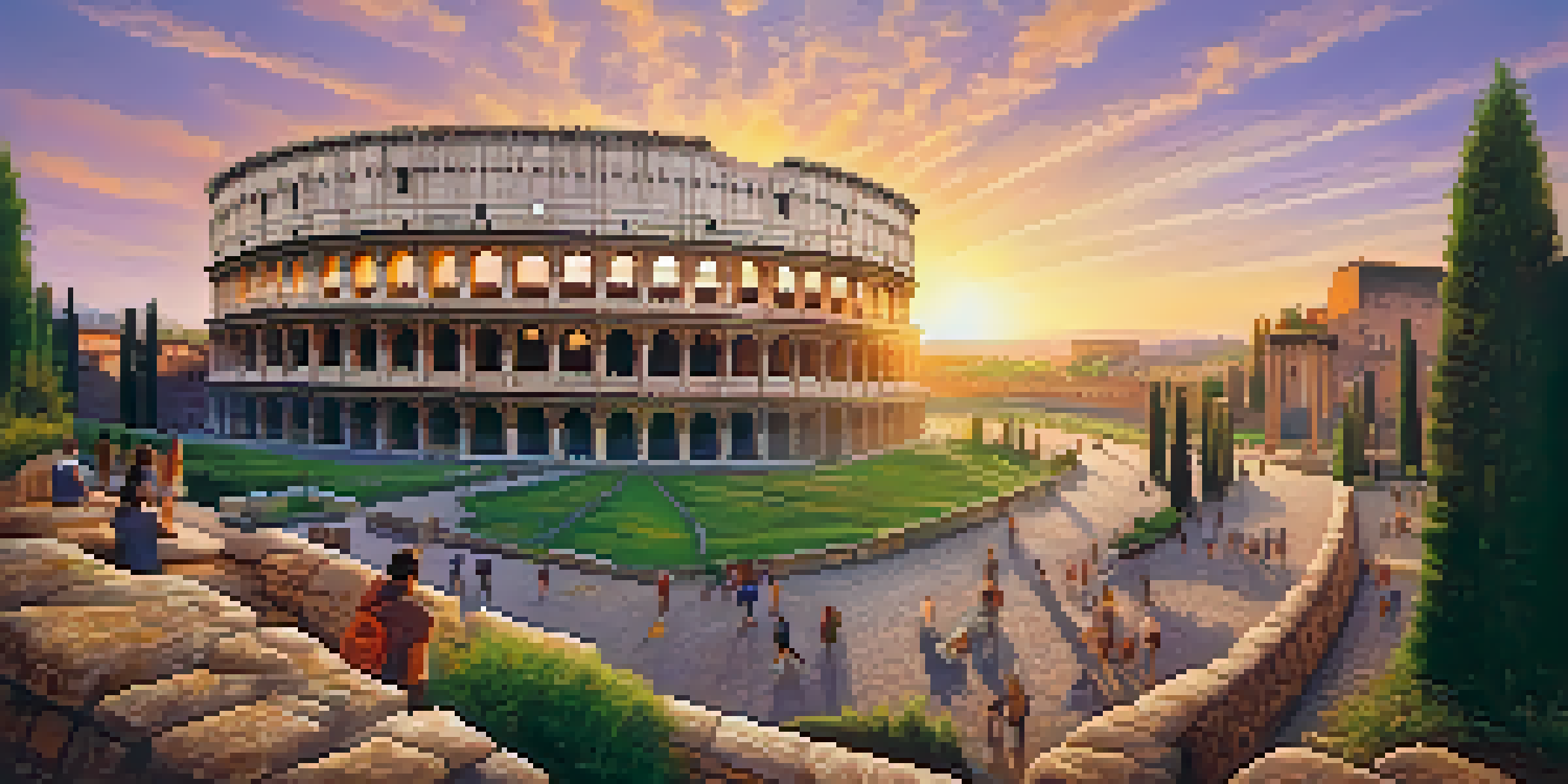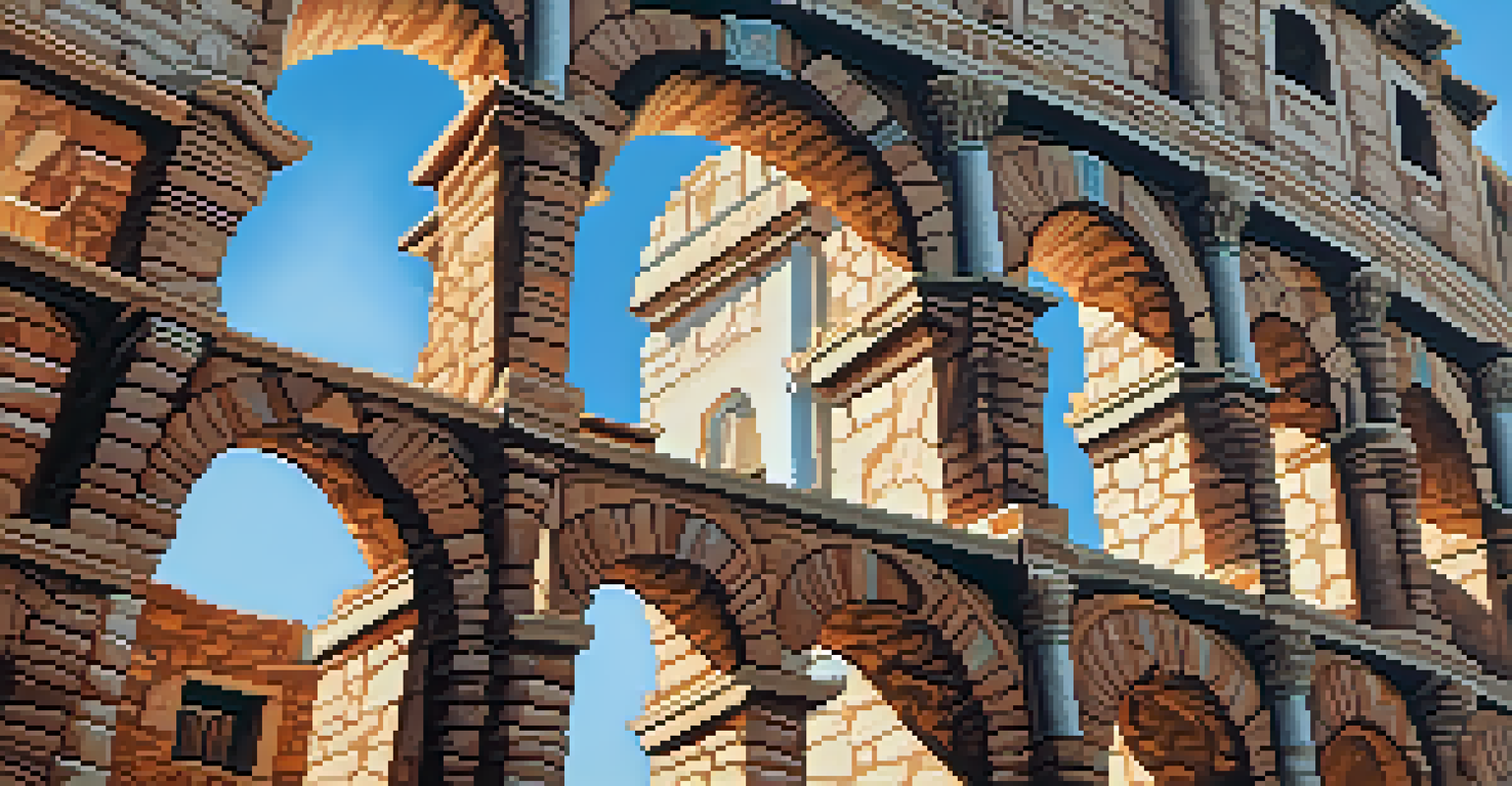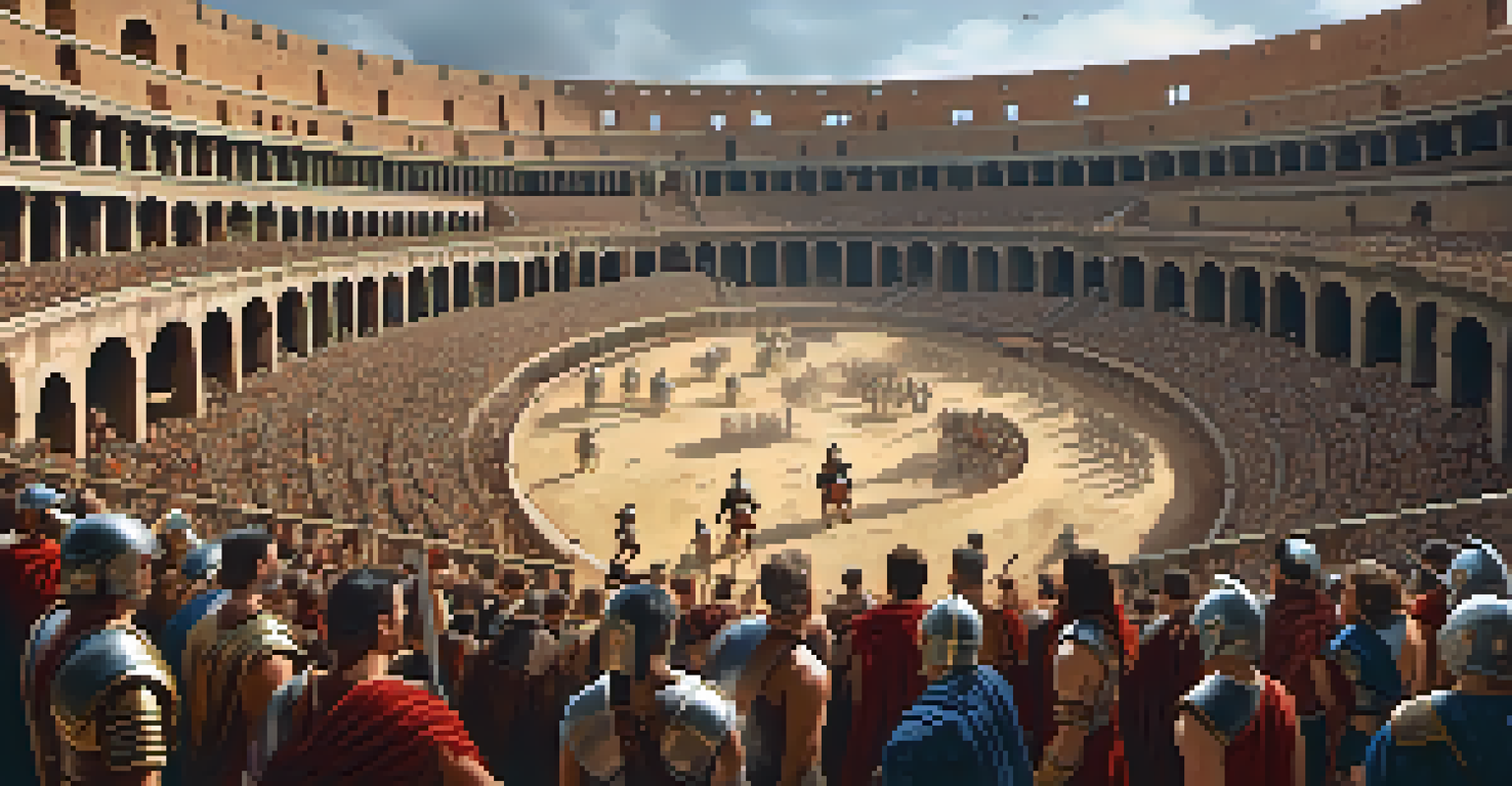The Colosseum: Rome's Iconic Arena and Its Historical Context

The Colosseum: A Marvel of Ancient Engineering
The Colosseum, also known as the Flavian Amphitheatre, stands as a testament to ancient Roman engineering prowess. Completed in AD 80, it could hold up to 80,000 spectators, showcasing an architectural innovation that was ahead of its time. Its elliptical shape and tiered seating allowed for an unobstructed view of the events held within, from gladiatorial battles to theatrical performances.
The Colosseum is the most important monument of ancient Rome, holding the memories of gladiators, emperors, and the people who filled its seats, a reflection of the society that built it.
This grand structure was built using concrete and stone, materials that provided durability and strength. The Colosseum’s design included a complex system of vaults and arches, which not only supported its massive weight but also contributed to its aesthetic appeal. Even today, the Colosseum remains one of the most recognizable symbols of Rome, drawing millions of visitors each year.
Beyond its physical structure, the Colosseum illustrates the sophistication of Roman society and culture. It was more than just an arena; it was a venue for social gatherings and a reflection of the values and entertainment preferences of the time.
The Purpose of the Colosseum in Ancient Rome
The Colosseum served as a grand stage for a variety of public spectacles, primarily gladiatorial contests. These events were not just entertainment; they were a way for emperors to display their power and gain favor with the populace. Over time, the arena hosted animal hunts, mock sea battles, and even executions, captivating audiences with their dramatic flair.

The games held at the Colosseum were often funded by emperors or wealthy citizens as a means to gain popularity. The phrase 'bread and circuses' summarizes this practice, highlighting how entertainment was used to distract and appease the masses. The sheer scale of the events, including the number of combatants and animals involved, showcased the wealth and resources of the Roman Empire.
Colosseum: Engineering Marvel
The Colosseum, completed in AD 80, exemplifies ancient Roman engineering with its innovative design and ability to hold up to 80,000 spectators.
Moreover, these spectacles served a deeper social function, fostering a sense of community among the citizens of Rome. They offered a shared experience that transcended social class, as people from all walks of life came together to witness the action unfold in the arena.
The Gladiators: The Stars of the Colosseum
Gladiators, the brave warriors who fought in the Colosseum, were often slaves or prisoners of war, but some volunteered for the fame and fortune that came with the role. These fighters underwent rigorous training, honing their skills to entertain the audience and survive the brutal contests they faced. Their battles were not just about physical strength; strategy and agility played crucial roles in determining the victor.
The Colosseum is a symbol of the enduring power of the human spirit, a reminder that even in the face of destruction, beauty and history can survive.
The life of a gladiator was fraught with danger and uncertainty. While some achieved celebrity status, complete with adoring fans and sponsorships, many faced a grim fate. The outcome of each bout could mean life or death, creating a thrilling yet perilous environment that captivated spectators.
Interestingly, gladiators were often revered as heroes, much like modern-day sports stars. Their bravery and prowess in the arena became the stuff of legend, with tales of individual gladiators passing into popular lore, further enhancing the allure of the games held at the Colosseum.
The Colosseum's Decline and Transformation
As the Roman Empire began to decline, the Colosseum's use also waned. By the early medieval period, the once-bustling arena fell into disrepair, and its stones were repurposed for other building projects. The grand spectacles that once drew crowds became a distant memory, as the focus of society shifted away from such brutal forms of entertainment.
Despite its decline, the Colosseum continued to hold significance. It was later used as a fortress, and even as a Christian shrine, demonstrating its enduring presence in the cultural fabric of Rome. This transformation reflects broader changes in societal values and priorities over the centuries.
Gladiators: Stars of the Arena
Gladiators, often slaves or prisoners, fought in the Colosseum for fame and survival, captivating audiences with their bravery and skill.
Today, the Colosseum stands not only as a symbol of ancient Roman civilization but also as a reminder of the passage of time and the evolution of entertainment. It has been preserved as an archaeological site and a UNESCO World Heritage site, attracting visitors who seek to understand its historical context and significance.
Cultural Impact of the Colosseum in Modern Times
The Colosseum's influence can still be felt today, inspiring countless works of art, literature, and film. Its iconic structure and storied past have made it a popular subject for artists and filmmakers alike. From epic movies that recreate gladiatorial battles to novels exploring the lives of ancient Romans, the Colosseum continues to capture the imagination.
Moreover, it has become a powerful symbol of Rome itself, often featured in travel guides and promotional materials. The image of the Colosseum evokes a sense of history and grandeur, making it a must-see destination for tourists from around the world. Its presence in popular culture serves to educate new generations about the marvels of ancient Rome.
In addition to its cultural significance, the Colosseum also plays a role in discussions about historical preservation and tourism management. Balancing the need to protect this ancient treasure while accommodating millions of visitors each year is an ongoing challenge that illustrates the complexities of heritage conservation.
Visiting the Colosseum: Tips for Travelers
If you're planning a visit to the Colosseum, there are a few tips to enhance your experience. First, consider booking your tickets in advance to avoid the long queues that often form outside. Guided tours can also provide valuable insights and stories that bring the history of the arena to life.
Timing is key; early morning or late afternoon visits tend to be less crowded, allowing you to explore without feeling rushed. Also, don’t forget to wander around the surrounding area. The Roman Forum and Palatine Hill are just steps away and offer a deeper understanding of the historical context of the Colosseum.
Cultural Legacy of the Colosseum
Today, the Colosseum remains a powerful symbol of resilience, influencing modern art, literature, and discussions about entertainment ethics.
Lastly, take a moment to appreciate the architecture and the atmosphere. Imagine the roar of the crowd and the thrill of the games that once took place in this magnificent arena. Engaging your senses will help you connect with the history and significance of this iconic landmark.
The Colosseum Today: A Symbol of Resilience
Today, the Colosseum stands not only as an ancient monument but also as a symbol of resilience and hope. It has withstood the test of time, surviving natural disasters and the ravages of history. Restoration efforts have been ongoing, ensuring that this iconic structure remains a part of our cultural heritage for generations to come.
The Colosseum also plays a role in contemporary discussions about violence and entertainment. As society reflects on the morality of consuming violent spectacles, the Colosseum serves as a historical reference point for understanding our complex relationship with entertainment. It prompts us to ask important questions about the nature of spectacle and the ethics of entertainment.

In essence, the Colosseum is more than just a relic of the past; it is a living symbol of human creativity, ambition, and the capacity for transformation. As we continue to explore its layers of meaning, we gain a greater appreciation for the rich tapestry of history that shapes our world today.